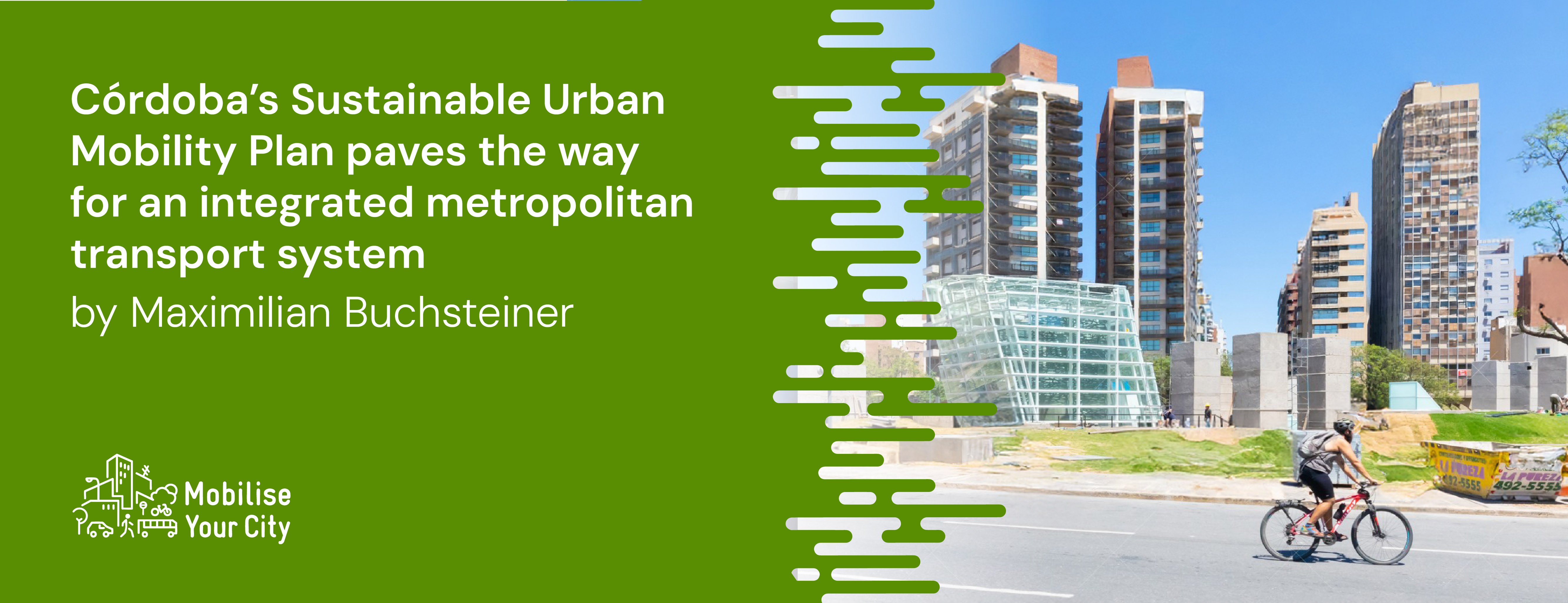Córdoba’s Sustainable Urban Mobility Plan paves the way for an integrated metropolitan transport system

With a population of 1.6 million and a rapidly expanding metropolitan area, Córdoba, Argentina’s second-largest city, is taking a major step toward sustainable mobility. The adopted Sustainable Urban Mobility Plan (PMUS Córdoba) provides a long-term strategic vision to make urban transport more inclusive, efficient and environmentally responsible across the Córdoba Metropolitan Area.
Funded by the European Union under the EUROCLIMA programme, the SUMP was implemented by the Agence Française de Développement (AFD) within the framework of the MobiliseYourCity Partnership. It was developed in close collaboration with the Municipality of Córdoba, Despacio, and a consortium led by Transamo, DVDH and Suez, together with IRV, Proyecto Habitar, Pares, and the National University of Córdoba.
A sustainable metropolitan vision for Córdoba
The SUMP, relying on one of the most comprehensive mobility studies ever carried out in Córdoba, includes the conduction of more than 2,500 household surveys as well as traffic and pedestrian counts at 40 key locations across the metropolitan area. The study measured travel times along 250 kilometres of roads and monitored air quality through sensors tracking fine particles (PM2.5 and PM10). All this data was brought together in a metropolitan mobility model using PTV Visum, allowing planners to simulate future traffic and emission scenarios.
The picture that emerged was both detailed and concerning, given that in over little more than a decade, private car use had risen sharply, from 26 to 42 percent of daily trips, while public transport’s share had fallen from 30 to 13 percent. Motorisation increased by 64 percent, reaching 264 vehicles per 1,000 inhabitants, and annual transport-related emissions climbed to around 450,000 tonnes of CO₂. These trends reflect a growing dependence on private mobility and a gradual pattern of urban sprawl that the SUMP now seeks to reverse.
Laying the groundwork for implementation
Córdoba’s SUMP sets out a structured three-phase action plan designed to guide implementation:
-
Reform service contracts for urban transport to improve service quality and financial sustainability
-
Restructure public transport networks around trunk, main and feeder lines, supported by infrastructure for active mobility and adapted transport services for people with disabilities
-
Develop a mass transit system, integrating Bus Rapid Transit (BRT) or other high-capacity modes within a restructured metropolitan network
Strategic targets for Córdoba's mobility transition
The SUMP translates this vision into a series of strategic targets and expected impact and defines measurable objectives to be achieved by 2030, including:
- An increase in the share of trips by public transport to at least 18 percent, by bicycle to 3.5 percent and on foot to 29 percent.
- To stabilise motorisation at around 265 vehicles per 1,000 inhabitants.
- To limit annual CO₂ emissions to roughly 500,000 tonnes, avoiding the increase projected under a “business-as-usual” scenario.
Modelling results show that, if these measures are fully implemented, active and public transport could reach a combined 55 percent of total trips, while car use would decline to around 35 percent. Such a shift would reduce congestion, improve air quality, and contribute to a more accessible and liveable city for all residents.
Inclusion, monitoring and long-term vision
Beyond infrastructure, the plan embeds social inclusion, gender equality and accessibility as core principles. Data show that people with disabilities make only 0.7 trips per day, half the mobility rate of others - a disparity the city seeks to address through improved accessibility and targeted services. The plan also introduces a Mobility Observatory to institutionalise data-driven policy and long-term monitoring.
Córdoba's SUMP provides a roadmap for sustainable mobility that balances metropolitan growth with social inclusion and environmental protection. It stands as an evidence-based policy tool built on cooperation between local and international partners. Aligning evidence-based policymaking with social and environmental objectives, it illustrates how cities can move from analysis to action. The technical assistance, amounting to EUR 600,000, marked the beginning of a broader investment pathway to reshape urban mobility across the metropolitan region. The coming years will determine how this strategic vision translates into tangible improvements on the ground and whether sustainable mobility can truly become the new norm for Córdoba and other metropolitan areas across Latin America.
Find out more about how Córdoba is shaping the future of sustainable mobility:
- Córdoba Sustainable Urban Mobility Plan (PMUS)
- MobiliseYourCity Factsheet: Córdoba, Argentina (2025)
- PMUS Córdoba Website